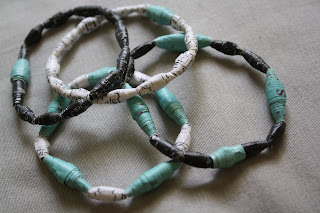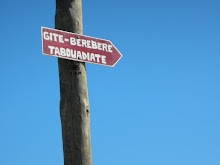Over the past two years I've had the opportunity to conduct a few workshops both with host country nationals as well as with Peace Corps volunteers. Each has been a uniquely different learning experience, mostly for myself.
About two weeks ago I agreed to facilitate a felting workshop at another volunteers' site. Felting is something that I do not consider myself an expert on. I learned the basics in my intro to fibers class back in college and felt confident that I had retained the important aspects of it, brushing up with a few YouTube videos just in case. I had about a week to prepare for the event so I worked on making samples of what is possible with felting. The group that I was going to be working with works mostly with knit wool, so I knitted two mostly identical swatches and proceeded to felt one of them so as to illustrate the difference in size and texture between the two fabrics. Next I felted a few beads, making two of them into a pair of earrings to show the ladies.

Finally, I wanted to create some felted...felt. I was able to find hand carders in my site, a tool I never actually used in college, but was unable to find the raw fleece itself. I tried ripping apart some wool yarn to use (which was good enough for making the beads), but it was clear that this was not going to work. I asked the volunteer that I was collaborating with if fleece was easily available in her site and if they would have it on hand for the workshop. This meant that I would have to go into the workshop with no example, no visual aid for this process which made me a little apprehensive about the workshop.
On the day of the workshop I arrived in the volunteers' site around 11:30am. After gathering the things I needed for the workshop and talking with the volunteer about what I would be showing the women, we headed over to their home. By this time it was 12 or 12:30 and after waiting on the doorstep for a few long moments under the hot August sun the door was opened. It was clear that we had interrupted the womans Ramadan sleep schedule. We then sat in her salon for several minutes while she obtained fleece from her "stash." The fleece she produced was dirty and matted and had been used as pillow fluff up until that moment.
At this point my Peace Corps college was apologizing and assuring me that she had indeed notified this woman about the workshop two days prior. These things, I have come to learn, happen and now I had to "make it work." The biggest obstacle in my opinion was the host country womans lack of motivation and excitement over learning this new process. Luckily, her sister was around and joined in on the workshop. At least
she was interested and willing to participate.
I first showed the women the samples that I had brought and briefly explained how I made the beads and how I had felted the knitted swatch. I was met with blank stares and decided to just get some wool into their hands so that they could make something.
The first thing we made were the felted beads. To make the beads we took some of the matted fleece in our hands, loosened it up by separating the fibers then dunking the tuft of fluff into alternating bowls of hot soapy water and ice cold water. Each time we removed the piece of wool from the water we rolled it in our hands to create a tight ball, as tight as we could make it.


It was then time to try to make the felt. I tried to explain that we needed to card the wool first, but that I wasn't very good at carding. That was my hint to the women which was supposed to mean "hey here's your chance to actually
do something! Why not just help me!?" The concept was lost until I actually started carding and it was clear that we'd be there
all day if they didn't step in to help, that was when one of the women reluctantly took over carding.

I proceeded to arrange the carded wool in the way that I was taught many years ago. The result was a very thick piece of wool and tender hands from dipping them into the scolding hot water. Shortly after starting my felting presentation the other, more enthusiastic sister told me that she'd seen this on TV, but said that in fact you didn't have to shock the wool (as I was doing with the hot and cold water), just use room temperature water with lots of soap. Now, I'm all for experimentation, but I didn't enjoy being contradicted in the middle of the workshop. The problem was that with no physical examples of something finished that they could make with the felt they had no idea what I was really talking about. It also meant that I had no authority to tell them how to make felt.

I was about ready to throw in the towel and wrap up the workshop when the non-enthusiastic-about-felting-sister inquired about a couple of unfinished coin purses that were stuck in the bag with the rest of my supplies. At that moment I dreaded with every fiber of my being what I was sure would come next, the question, "will you show me how you did this?" As much as felting is not my forte at this juncture of my life, crocheting with two colors in the round is something that I've mostly mastered since coming to Morocco. I enjoy doing it, and just as importantly, I enjoy teaching Moroccan Women as well as fellow Peace Corps volunteers how to do it. Now everyone learns differently and at their own speed, but considering that it took me four days and over 30 hours to teach two ladies in a different volunteers' site recently (more on that later), I just knew I didn't have the energy to go down this road with this woman. As a compromise I sat down and crochet one small flower motif, explaining what I was doing as I went and showed her how what I did corresponded to the directions I had written out. Afterward I gave her the crochet sample along with a copy of the written directions.
The volunteer who's site this was is very enthusiastic about working with other girls in the community to make jewelry out of the felted beads, since there are many girls in her small town with nothing to do. I hope that this project works out for them, so that some good will come of this workshop. I guess we'll just have to wait and see, like so many other projects here in Morocco.










































